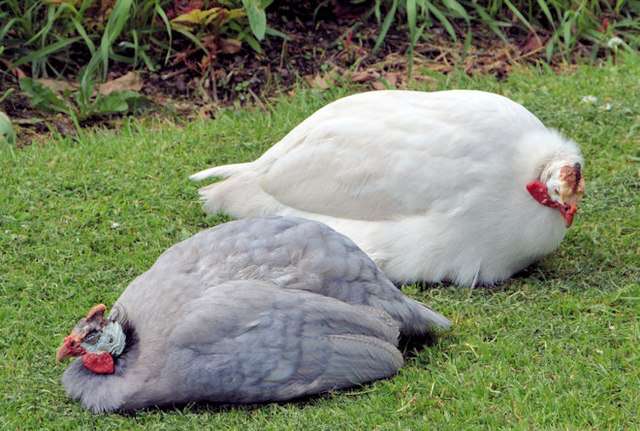SCORES & OUTDOORS: What is that funny-looking chicken?
 by Roland D. Hallee
by Roland D. Hallee
A little while back, I went to a friend’s house at the lake to help bring in his dock. But before we did that, he had to go to Hannaford to pick up his weekly issue of the Boston Sunday Globe – he wouldn’t read anything else. I stayed back to start getting things ready.
When he returned, he asked me about a flock of birds he had seen crossing the road that looked like fat, gray chickens. Immediately, the guinea fowl came to mind. Rather than have him describe the bird to me, I described it to him, and it was exactly what he had seen.
Guinea fowl, Numida meleagris, in our area are generally domestic stock, kind of like chickens and bantams. It is believed they are of West African origin. There are two common varieties, the Pearl and the White. The bird rarely weighs over 3-1/2 pounds, although they appear larger than this alive. The bones are quite small, and the carcass produces a relatively large amount of meat.
There is good demand for Guinea fowl in the large markets, and because of their wild game flavor the birds are served extensively in the larger hotels and higher priced restaurants.
The eggs are small, of dark color and fine flavor, and are apt to be laid in secluded places in the grass and weeds.
It is not easy to distinguish the sex of Guineas. The male has slightly larger head appendages and the female seldom screeches like the male. They are normally monogamous, mating for life. All guinea fowl are social, and typically hang out in small groups.
The Guinea fowl is a family of insect-eating, ground-nesting bird that resemble partridges, but with featherless heads. Most speciest have a dark gray or blackish plumage with dense white spots.
Guinea fowl have a long history of domestication, mainly involving the helmeted Guinea fowl. They eat lice, worms, ants, spiders, weedseeds and ticks while on the range.
They are a very noisy bird, and are said to be good for controlling the Lyme disease-bearing deer tick. They range well and eat lots of small things. In fact, if you keep bees, you don’t really want to keep guineas. They’ll stand by the hive and snap up the bees as they come out. Some have reported that since they started keeping guinea fowl, they have not seen yellow jacket hives in their fields.
You can reduce ticks and other insects by raising them. They are a little tricky to raise, but they are interesting, friendly and they eat bugs. Contrary to popular opinion, they are quite intelligent.
Guineas often lay their eggs in fields and hatch their young by themselves. Being native to dry areas of Africa, they are very susceptible to dampness during their first two weeks, and can die from following their mother through dewy grass. After two weeks of age, they are probably the hardiest of all domestic land fowl.
Guinea fowl live in the wild once you raise and release them.They are territorial so they will stay pretty much in one area.
Once you have raised them, their release can be tricky. If you release them all at one time, they may wander off forever. The best bet is to release one or two. They will hang near the others in the hutch. They hate to be alone. After dusk, you will find them roosting on the ground nearby. Capture them from the top so they can’t open their wings. This shouldn’t hurt them. Wear gloves as their claws and beaks are sharp. Put them back in the hutch and let another pair out the next day.
They are extremely vulnerable to hawks, cats and raccoons. They are most vulnerable when they are bedded down as a group at night. These birds cannot fly when their feathers are wet.
Do not confine male guineas with chickens if there are roosters in the same flock. Male guineas will run the roosters ragged and keep them from food and water. Females do not cause the same problems.
If you wish to raise Guinea fowl, there is much information on-line on that subject. Your local feed store will either sell keets (babies) or they will be able to tell you who does. You will need 15-20 to get started as they have a high mortality rate. They generally cost $3 – $5 each. There are benefits to raising these birds but there are some tricky steps along the way. Make sure you have done some homework, not to mention having the room (their range is usually 3 – 5 acres) before you begin to raise these wonderful birds.
During our many trips to Mexico, and the Caribbean, for that matter, my wife and I have noticed Guinea fowls are kept at all the resorts we have stayed at to control insects.
I have seen several Guinea fowl in the central Maine area, and maybe there should be more of them, considering the large population of deer ticks that have been reported lately.
Roland’s trivia question of the week:
In what year did the Boston Patriots become the New England Patriots?
Responsible journalism is hard work!
It is also expensive!
If you enjoy reading The Town Line and the good news we bring you each week, would you consider a donation to help us continue the work we’re doing?
The Town Line is a 501(c)(3) nonprofit private foundation, and all donations are tax deductible under the Internal Revenue Service code.
To help, please visit our online donation page or mail a check payable to The Town Line, PO Box 89, South China, ME 04358. Your contribution is appreciated!



Leave a Reply
Want to join the discussion?Feel free to contribute!